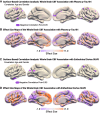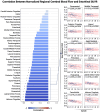Cerebral blood flow is associated with plasma and PET biomarkers of tau pathology in middle age
- PMID: 40620471
- PMCID: PMC12226452
- DOI: 10.1093/braincomms/fcaf249
Cerebral blood flow is associated with plasma and PET biomarkers of tau pathology in middle age
Abstract
Cerebrovascular dysfunction is associated with risk and progression of Alzheimer's disease, but the extent to which it promotes Alzheimer's pathophysiology is unclear. Understanding the relationship between cerebrovascular dysfunction and Alzheimer's disease markers in midlife is critical to inform our understanding of the earliest manifestations of the disease and prevention strategies. We examined the association of cerebral blood flow with two biomarkers of tau pathophysiology, plasma phosphorylated tau 181 (p-tau181) concentrations and tau PET MK6240 standard uptake value ratio. This was a cross-sectional study of participants in the Offspring Study in upper Manhattan. Analyses included arterial spin labelling MRI, plasma p-tau181 concentration and 18F-MK-6240 tau PET data in the entorhinal cortex. Four hundred and fifty-nine participants (54.8 ± 10.8 years old, 63.3% women) had available MRI and plasma p-tau181 data, and 98 (60.4 ± 5.8 years old, 61.2% women) had additional tau PET data. Lower cerebral blood flow was associated with both higher plasma p-tau181 concentration and entorhinal cortex tau standard uptake value ratio. Higher plasma p-tau181 levels were associated with small clusters of lower regional cerebral blood flow, primarily in regions that correspond to sites of early Alzheimer's disease pathology. Higher tau PET levels were associated with lower cerebral blood flow throughout the brain. These findings suggest that there is relationship between cerebral blood flow and indicators of tau pathophysiology in middle age that is likely bidirectional.
Keywords: Alzheimer’s disease; biomarkers; blood flow; neuroimaging; tau.
© The Author(s) 2025. Published by Oxford University Press on behalf of the Guarantors of Brain.
Conflict of interest statement
A.M.B. has consulting/advising arrangements with Cogstate, Cognito Therapeutics, Tau Biosciences, CogniScreen IQVIA, and Cognition Therapeutics. A.M.B. is an inventor a patent for white matter hyperintensity quantification (US Patent US9867566B2), serves on a Data Safety Monitoring Board for University of Illinois, Urbana-Champaign, and is a section editor for Alzheimer’s & Dementia.
Figures




References
Grants and funding
LinkOut - more resources
Full Text Sources
